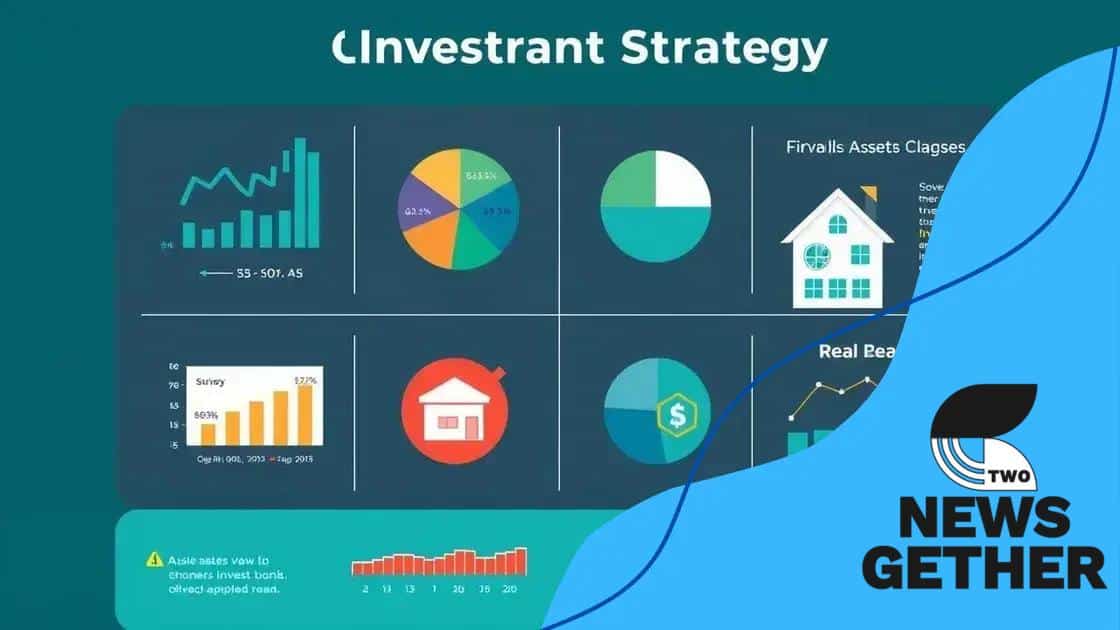Investment strategies for millennials in uncertain markets

Investment strategies for millennials in uncertain markets include setting clear financial goals, understanding risk tolerance, diversifying assets, leveraging technology, and regularly reviewing and adjusting your plan as circumstances change.
Investment strategies for millennials in uncertain markets require a fresh perspective. How do today’s uncertainties affect your financial decisions? Let’s uncover strategies that could secure a brighter future.
Understanding market uncertainties
Understanding market uncertainties is essential for anyone looking to invest wisely. Investors often face volatile market conditions that can lead to confusion and hesitation. By recognizing these uncertainties, you can take more informed steps towards building your portfolio.
What Causes Market Uncertainties?
Market uncertainties can arise from various factors, including economic indicators, political events, and unexpected global situations. These influences can change rapidly, affecting investor sentiment and stock values.
- Shifts in interest rates can impact borrowing costs.
- Changes in government policies can create uncertainty.
- Natural disasters and pandemics can disrupt markets.
- Technological advancements can alter industry landscapes.
Understanding these causes helps you navigate your investment strategies. For example, when interest rates rise, it’s often a sign that the economy is attempting to cool down. This can lead to a cautious approach in choosing growth investments.
Mitigating Risks
To mitigate risks associated with uncertainties, consider diversifying your investments. Instead of putting all your funds into one area, you can spread your investments across various sectors. This strategy helps reduce the impact of a downturn in any single sector.
Another way to combat uncertainty is to remain flexible in your investment approach. Instead of sticking strictly to one plan, be open to adjusting your strategies based on market trends. This adaptability can position you favorably regardless of market conditions.
Ultimately, being informed and adaptable is key. By understanding market uncertainties and their implications, you can make better financial decisions that lead to long-term success.
Risk tolerance and its importance
Risk tolerance is a critical factor in creating a successful investment strategy. Understanding your own risk tolerance helps you make informed decisions and avoid unnecessary stress. When you know how much risk you can handle, you can choose investments that align with your financial goals.
What is Risk Tolerance?
Risk tolerance refers to the degree of variability in investment returns that you are willing to withstand. It’s essential to assess this level before making investment choices. Factors such as age, financial situation, and emotional resilience can influence your risk tolerance.
- Age: Younger investors often have a higher risk tolerance because they have time to recover from losses.
- Financial Situation: Those with more savings can afford to take greater risks.
- Emotional Resilience: Some people are more comfortable with fluctuations in their investments than others.
When determining your risk tolerance, consider conducting a self-assessment. This can help you gauge your comfort level with different types of investments, such as stocks, bonds, or mutual funds. Stocks are typically more volatile, while bonds are often seen as safer bets.
Why is Risk Tolerance Important?
Understanding your risk tolerance is vital for several reasons. It helps you select the right investment portfolio that suits your comfort and financial objectives. A mismatch between your portfolio and your risk tolerance can lead to anxiety and poor decision-making.
Moreover, recognizing your risk tolerance allows you to prepare for market fluctuations. If you know you can tolerate risks, you may choose to hold onto an asset through downturns. On the other hand, if you realize you can’t handle losses, it might be wise to adopt a more conservative approach.
Ultimately, aligning your investments with your risk tolerance ensures that you remain focused on your long-term financial goals without becoming overwhelmed by market volatility.
Diverse asset allocation strategies

Diverse asset allocation strategies are essential in today’s investment landscape. By spreading your investments across various asset classes, you can manage risk and potentially enhance returns. A well-structured asset allocation strategy is tailored to your financial goals and risk tolerance.
Understanding Asset Classes
Asset classes are categories of investments, each with different characteristics and risk levels. Understanding these classes helps in creating a balanced portfolio. The main asset classes include:
- Stocks: Equities representing ownership in companies, usually higher risk but also higher potential returns.
- Bonds: Debt securities that pay interest, generally considered safer than stocks.
- Real Estate: Physical properties or REITs that can provide income and appreciation.
- Cash and Cash Equivalents: Liquid assets that have minimal risk but lower returns.
By investing in a mix of these asset classes, you can cushion your portfolio against market volatility. For example, during stock market declines, bonds can help stabilize your returns.
Creating a Balanced Portfolio
Creating a balanced portfolio involves deciding how much to allocate to each asset class based on your investment objectives. A common rule of thumb is to consider your age: younger investors might lean more toward stocks for growth, while older investors may shift toward bonds for stability.
Another important factor is market conditions. When the economy is strong, stocks tend to perform well. Conversely, in uncertain or weak economic times, safer investments like bonds may be more desirable. This dynamic nature of asset allocation allows investors to adapt to changing markets.
Regularly reviewing your allocations to ensure alignment with your evolving goals is key. Adjusting your strategy might be necessary as your situation changes, such as moving towards retirement or achieving specific financial milestones. Ultimately, a diverse asset allocation strategy helps you navigate market ups and downs more effectively.
Incorporating technology in investing
Incorporating technology in investing has become essential for modern investors. Today, tools and platforms can simplify the investment process, making it more accessible and efficient for everyone, especially millennials. By leveraging technology, you can enhance your investment decisions and manage your portfolio more effectively.
Emerging Investment Apps
Many new investment apps cater to different needs and preferences. These platforms allow you to buy and sell stocks, mutual funds, and cryptocurrencies with just a few taps on your phone.
- Robo-advisors: Automated services that create and manage investment portfolios based on your risk tolerance and financial goals.
- Stock trading apps: Allow real-time trading of stocks and offer research tools to help you make informed decisions.
- Budgeting apps: Help track your expenses and savings, making it easier to allocate funds for investments.
These technology solutions not only save time but also provide valuable insights into market trends and investment opportunities.
Using Data Analytics
Data analytics plays a pivotal role in modern investing. By analyzing vast amounts of financial data, investors can make more informed decisions. For instance, predictive analytics can forecast market trends, helping you identify when to enter or exit investments.
Additionally, platforms can offer customized reports and visualizations that make complex data easier to understand. With these tools, you can track your portfolio performance and make adjustments in real-time.
Staying ahead of the curve in technology within investing can provide a competitive advantage. It allows for better risk management and helps you stay informed about global events that could impact your investments.
Building a long-term investment plan
Building a long-term investment plan is crucial for achieving your financial goals. A well-structured plan helps you stay focused and disciplined, especially in uncertain markets. By setting clear objectives and following a strategy, you can make investing feel more manageable and rewarding.
Setting Your Financial Goals
The first step in creating a long-term investment plan is to define your financial goals. Determine what you want to achieve, whether it’s saving for retirement, buying a home, or building an education fund for your children.
- Short-term goals: These could include saving for a vacation or a car.
- Medium-term goals: These may involve a down payment for a house.
- Long-term goals: Think about retirement savings or funding your children’s college education.
By categorizing your goals, you can better plan and allocate resources to meet each target.
Creating an Investment Strategy
Once your goals are set, the next step is to develop an investment strategy that aligns with them. Consider your risk tolerance and the time horizon for achieving your goals. For instance, if you’re investing for retirement 30 years away, you might take more risks than if your goal is just a few years away.
Diversifying your investments across different asset classes is another critical aspect of an effective strategy. This helps to balance potential risks and rewards, allowing your portfolio to weather market fluctuations.
Regularly reviewing and adjusting your plan is essential. As your life circumstances change, such as a new job or family obligations, your plan should adapt accordingly. By staying flexible, you can ensure that your investment strategy aligns with your current financial situation and future aspirations.
In conclusion, building a solid long-term investment plan is essential for achieving your financial goals. By setting clear objectives, understanding your risk tolerance, and incorporating a diversified strategy, you create a pathway to successful investing. Technology can further enhance your experience, offering valuable insights and tools to navigate the market effectively. Remember to regularly review and adjust your investment plan as your circumstances change. With commitment and informed decision-making, you can reach your financial aspirations!
FAQ – Frequently Asked Questions about Building a Long-Term Investment Plan
What is the first step in creating a long-term investment plan?
The first step is to set clear financial goals, such as saving for retirement or buying a home.
How do I determine my risk tolerance?
You can assess your risk tolerance by considering your age, financial situation, and comfort level with market fluctuations.
Why is diversification important in investing?
Diversification helps to spread risk across different asset classes, which can stabilize your portfolio during market volatility.
How often should I review my investment plan?
It’s recommended to review your investment plan regularly, especially when your life circumstances or financial goals change.






